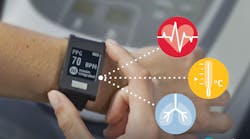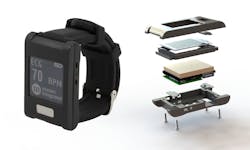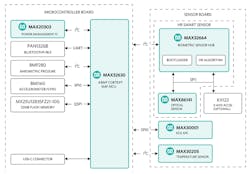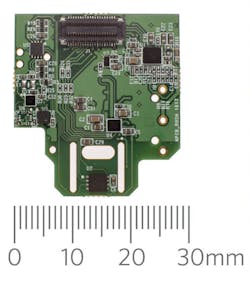Maxim Integrated Products’ first Health Sensor Platform (HSP) made it much easier to build wearable devices. However, the latest version—HSP 2.0 (Fig. 1)—lets developers monitor electrocardiogram (ECG), heart rate, and body temperature. The modular system is designed to handle upgrades or enhancements, which in the long run can save developers months of design and implementation work.
1. Maxim’s Health Sensor Platform 2.0 (left) can monitor ECG, heart rate, and skin temperature. The device can be taken apart (right) to enable changes or upgrades to the sensor system.
The $399 HSP 2.0 contains a number of Maxim Integrated’s components, starting with the Darwin low-power MAX32630 ARM Cortex-M4F microcontrollers. The platform is tied into a MAX32664 sensor hub (Fig. 2) that handles a range of sensors, including the MAX86141—an optical sensor that tracks heart rate as well as being a pulse oximeter. The MAX30001 analog front end (AFE) handles the ECG sensors, while the MAX30205 handles temperature to within 0.1°C. Maxim also covers power management with its MAX20303 PMIC, which is critical for such mobile devices.
2. The HSP 2.0 is built around Maxim’s MAX32630 ARM Cortex-M4F tied to a MAX32664 sensor hub that handles a range of sensors.
In addition, the HSP 2.0 uses third-party chips and modules, including the Bluetooth support. The system is charged and managed with a USB Type-C connection. The compact module has an expansion header and display interface and contains the processor and Bluetooth support (Fig. 3).
ARM Mbed supports the MAX32630 microcontroller. This provides access to a large, open-source library of tools as well as a development and IoT communication framework. System software support for over-the-air updates is in the works. The MAX32630 also includes a secure element that can provide encryption and secure key support. An Android application is also provided that allows for remote viewing of data.
3. The processor module is compact with an expansion header.
The platform doesn’t have FDA approval as a medical device, but a developer could use it as the basis for such a product. It’s a matter of getting the appropriate approvals so that data could be utilized by medical professionals. Of course, the device can be used to acquire and provide information to users.
Maxim Integrated has put together an amazing package that opens opportunities for professional developers and makers. There’s no comparable platform available elsewhere. Its modular approach enables future hardware upgrades as well as custom sensor arrays without incurring major redesign costs.





